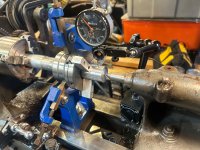RidgeRaider
Well-known member
So I got a cue man 3 jaw chuck on a bearing to put in my steady rest on my atlas lathe.
I’ve got it close to aligned by getting it to .005 runout on the dial indicator, but can’t get it zeroed.
I’m using the method of putting stock in my lathe, turning it true, putting a center on it, then putting the 3 jaw on and zeroing the piece with the 3 jaw on. Then install the steady rest and clamp it on the bearing with the tail stock engaged.
It seems no matter what I do, I can’t get it zeroed. Is this a fools errand to try and zero this? I have the DNA adjustable collet system on order, hoping that takes out the last bit of it, but I am not sure if the steady rest not being zeroed is gonna be an issue.
Any advice or thoughts on how to get it zeroed, or should I just say good enough and wait for the collet system?
I’ve got it close to aligned by getting it to .005 runout on the dial indicator, but can’t get it zeroed.
I’m using the method of putting stock in my lathe, turning it true, putting a center on it, then putting the 3 jaw on and zeroing the piece with the 3 jaw on. Then install the steady rest and clamp it on the bearing with the tail stock engaged.
It seems no matter what I do, I can’t get it zeroed. Is this a fools errand to try and zero this? I have the DNA adjustable collet system on order, hoping that takes out the last bit of it, but I am not sure if the steady rest not being zeroed is gonna be an issue.
Any advice or thoughts on how to get it zeroed, or should I just say good enough and wait for the collet system?

